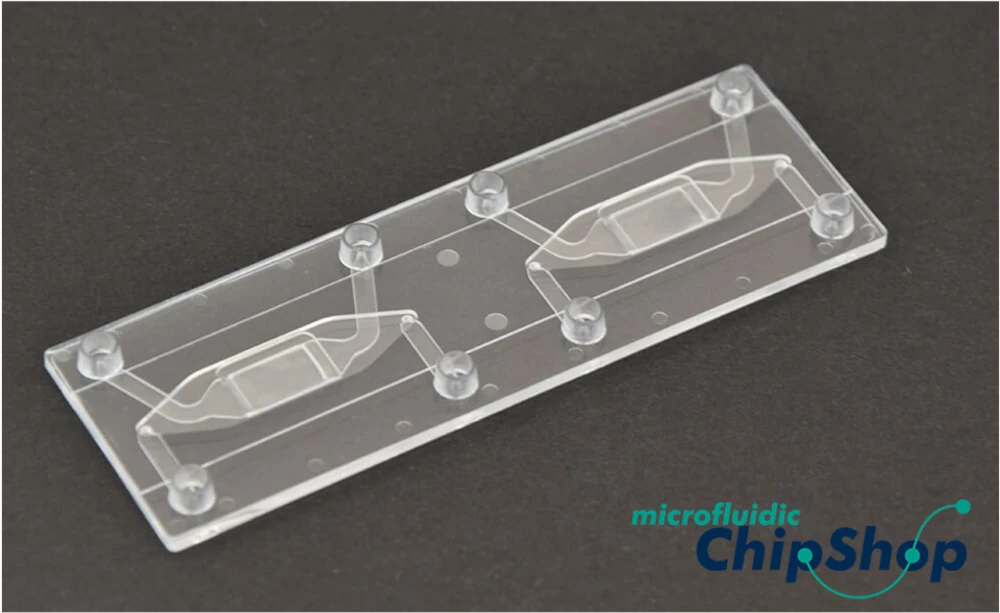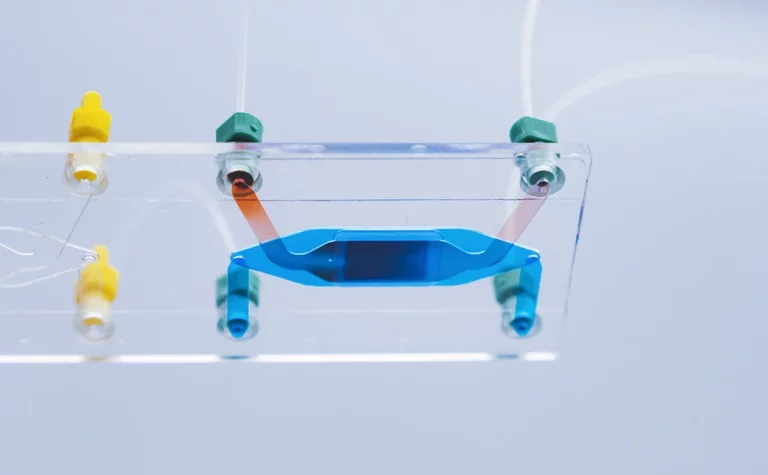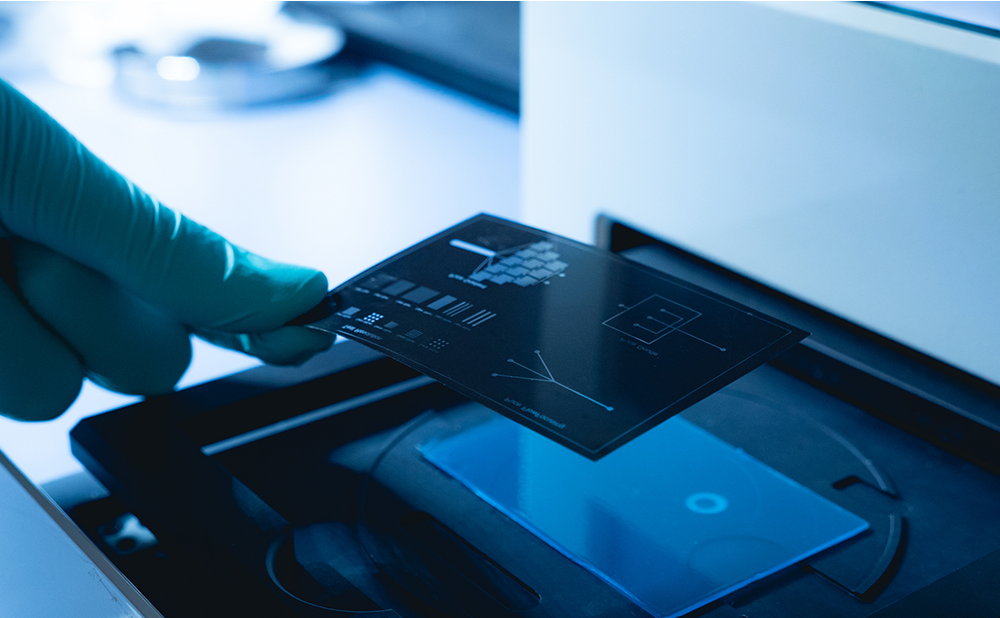Kidney-on-a-chip
Physiological microenvironment for a more realistic in vitro kidney model
Enrich the media with metabolites
Circulate media to collect molecules and assess cellular response
Use the chip of your preference
Mimic the proximal, distal tubules and/or glomerulus on chip
Physiological flow rates
High control of flow rates to induce cell polarization

Need a microfluidic SME partner for your Horizon Europe project?
Image Credit: Kidney proximal tubule. David Gregory & Debbie Marshall. Licence: Attribution 4.0 International (CC BY 4.0)
Kidney-on-a-chip pack setup
Different areas of the kidney have been reproduced on-chip, such as proximal [1] and distal tubules [2], the glomerulus [3, 4], or the nephron [5]. Our setup allows you to use a single design to work with the model(s) most adapted to your application.
The unidirectional cellular perfusion module, connected to the reservoirs, provides media to the chip in a controlled and automated manner. As the schematic exemplifies, when working with a barrier model with a membrane chip, each chamber’s flow rate and direction can be chosen to reproduce the in vivo reality better.


The kidney-on-a-chip pack includes:
Flow sensor (Galileo, MIC)
Recirculation bridge
Smart culture tube rack
Software (Galileo user interface)
Flow controller
Reservoirs for precursor solutions
Several falcon reservoirs
Tubings and fittings
Microfluidic chip of your choice
User guide
References
Ng CP, Zhuang Y, Lin AWH, Teo JCM. A fibrin-based tissue-engineered renal proximal tubule for bioartificial kidney devices: development, characterization and in vitro transport study. Int J Tissue Eng. 2013; article ID 319476.
Ferrell N, Ricci KB, Groszek J, et al. Albumin handling by renal tubular epithelial cells in a microfluidic bioreactor. Biotechnol Bioeng. 2012;109:797–803
Musah S, Mammoto A, Ferrante TC, et al. Mature induced-pluripotentstem-cell-derived human podocytes reconstitute kidney glomerular-capillary-wall function on a chip. Nat Biomed Eng. 2017;1. article number: 0069.
Zhou M, Zhang X, Wen X, et al. Development of a functional glomerulus at the organ level on a chip to mimic hypertensive nephropathy. Sci Rep. 2016;6:31771
Weinberg E, Kaazempur-Mofrad M, Borenstein J. Concept and computational design for a bioartificial nephron-on-a-chip. Int J Artif Organs. 2008;31:508.
A little more about the suggested chip: Fluidic 480
The fluidic 480 cross-flow membrane chip from Microfluidic ChipShop represents a microfluidic chip system for adherent cell culture and, thus, the generation of diverse cellular tissues and organoids. Cell cultivation takes place on the integrated membrane.
The device comprises two in- and outlet ports above and below the membrane that allow molecule transfer. Different pore sizes, materials, and chip geometries with more inlets are also available.

- Suitable for metabolic studies, cell co-cultures, and organ-on-chip experiments
- Compartments divided by a permeable membrane
- Membrane pores from 8 to 0.2 µm
- Chip available in TOPAS or PS
- Interaction area of 36mm2
- Connectors: mini luer
- Upper chamber internal volume: 87.5 µl
- Bottom chamber lower volume: 61.5 µl
Other compatible chips include Fluidic 568 and Fluidic 846.
Compatibility of kidney-on-a-chip pack
Our kidney-on-a-chip pack was designed to be compatible with commercially available or homemade chips (specific adaptors might be required) and the most common supernatant assays. If you have a particular chip or assay not listed, don’t hesitate to contact us using the green button above.
Chips


PMMA Device Station
From mold development to high-resolution PMMA chip fabrication
✓ Fast process
✓ Multiple applications
✓ Simple and innovative setup
PMMA
Synvivo
And many more!
Assays
TEER
Immunostaining of endothelial cell markers
Albumin reabsorption
3D reconstructions
Perfusion assay, using fluorescent dyes
Pharmacokinetics assays
Immunohistochemical and histopathological characterization
Toxicity assays
Kidney-on-a-chip applications
1. ADME analysis: The kidney-on-a-chip model can be part of a drug’s absorption, distribution, metabolism, and excretion simulation system for a better understanding of drug influence in each organ.
2. Physiology modeling: Replicating the kidney microenvironment in vitro allows a deeper understanding of biological processes related to human physiology.
3. Disease modeling: A better understanding of the underlying mechanisms of diseases can be achieved with more apt models, such as the different versions of the kidney-on-a-chip.
4. Preclinical testing: The most powerful argument for using on-chip models is the possibility of using them to test the safety and efficacy of new drugs before they are tested in humans. This could reduce the number of animals used in preclinical testing and improve drug testing accuracy.

If you want to know more about organ-on-a-chip technology, have a look at this review!
Customize your pack
We offer compatible instruments for standard commercialized chips from various brands. We can customize your pack to suit your specific needs with guidance from our specialists, who will suggest the best instruments and accessories. We’ll also help you set up the perfusion platform.
Frequently asked questions
Can I order a pack?
Since Packs are products that are still being developed, we have a few eligibility criteria to maximize their success rate. A discussion with our experts is needed to determine your specific needs to offer you a personalized response.
Can the modules be sterilized/autoclaved?
Yes, we have developed a simple protocol for sterilization and cleaning that is provided along with the user guide.
Can a pack be customized based on my specific application?
Yes! Our experts will establish which instruments are best suited for your application, such as the type of flow sensor or the number of flow controller channels you need to perform your experiment. Contact us using the “talk to our experts” green button above.
Can I buy individual instruments?
Our instruments are in beta testing phase and can be tested as a pack or individually, so get in contact with our team to know how our beta testing program works.




